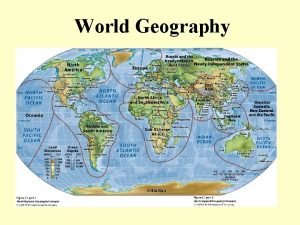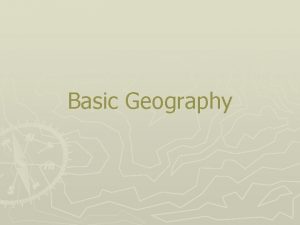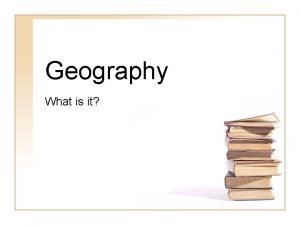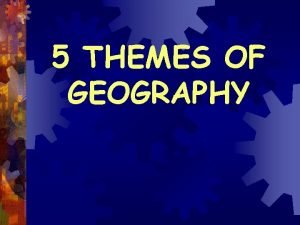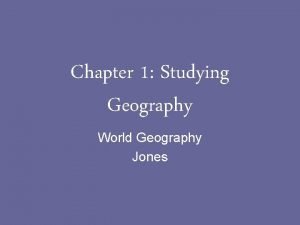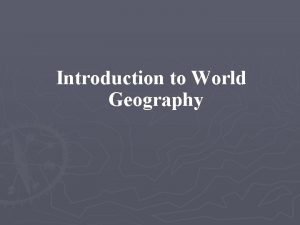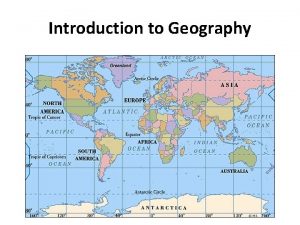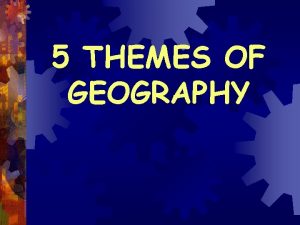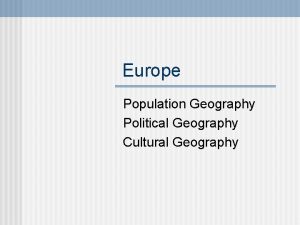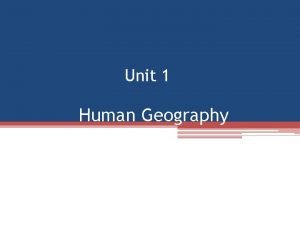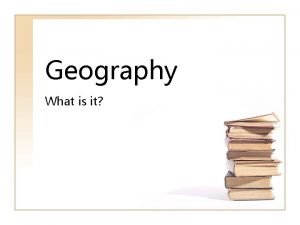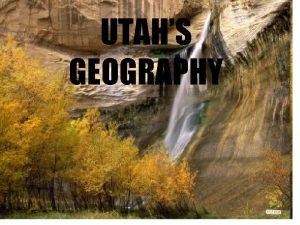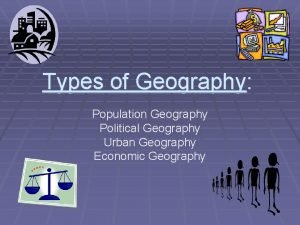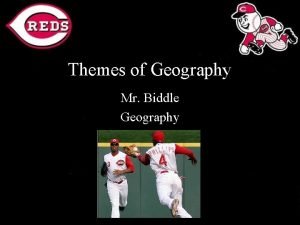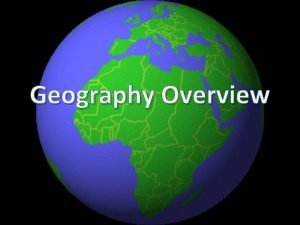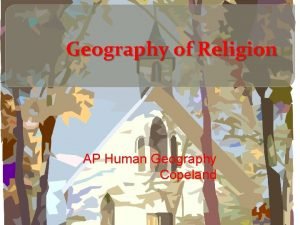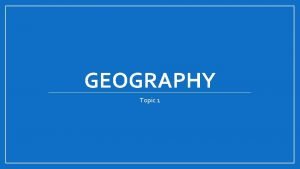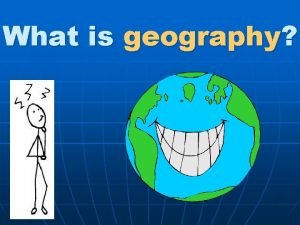What is Geography Geography Geography is the study

































- Slides: 33

What is Geography?

Geography § Geography is the study of the distribution and interaction of physical and human features on the earth’s surface

Tools that Geographers Use § Geographers use many different types of tools in order to understand the earth and how people interact with the earth

Maps and Globes § The two most important tools geographers use are maps and globes. Maps are two dimensional representations of the earth’s surface and globes are three dimensional representations of the earth’s surface.

Other Tools § § § § GIS Field Work Satellite Images Photographs Databases Primary Sources Diagrams

GIS § GIS stands for Geographic Information System (Page 12) § A GIS combines information about a place from several sources such as databases, maps, and satellite images in order to solve a problem

Field Work § Field work is when a geographer travels to a location in order to study it. The geographer may interview people, take pictures, use surveying equipment, or make personal observations.

Satellite Images § Satellites are human made objects that orbit the earth. § Landsat - A series of satellites that orbit more than 100 miles above the earth. § Geostationary Operational Environment Satellite (GOES) http: //www. oso. noaa. gov/goes/ http: //landsat. gsfc. nasa. gov/about/

Photographs § Geographers can take aerial photographs from airplanes in order to better understand an area.

Databases § A database is a collection of information in a computer. The data can be anything from the different ethnic groups that live in an area to how much the average family earns in a year.

Primary Sources § Geographers often rely on direct observation in studying the earth and patterns of human activity. Primary sources can be books, articles, interviews, and pictures to name a few.

Globes and Maps

Globes § Globes are three dimensional representations of the earth

Advantages of Globes § Globes are more accurate than maps § Globes are not distorted

Disadvantages of Globes § Globes are not portable § Globes do not show detail § Globes are more expensive than maps § There are no thematic globes

Maps § Maps are two dimensional representations of the earth

Advantages of Maps § Maps are cheaper than globes § Maps show detail § Maps can show themes (thematic maps) and be used for comparing things § Maps can be put into a book called an atlas § Maps are portable

Disadvantages of Maps § Maps are distorted because the earth is not flat § Maps can distort shape, area, direction, and distance § This problem is somewhat solved by different map projections

Map Projections § Map projections are a way to draw maps in order to lessen distortion. There are different types of projections because people use maps for different reasons.

Mercator

Mercator § The Mercator is used by ship navigators How do you identify it? a. It is square b. The latitude and longitude lines are at right angles c. The top and bottom of the map are heavily distorted (Greenland is ginormous!)

Polar

Polar § a. b. c. d. The Polar projection is used by airline pilots because it shows the shortest distance between two points How do you identify it? It is a circle It only shows one hemisphere The latitude lines are circles The longitude lines radiate from the center

Robinson

Robinson § The Robinson projection is used to compare data. How do you identify it? a. It has curved sides b. The longitude lines curve towards the north and south pole

Different Types of Maps § Political Maps § Physical Maps § Topographic Maps § Thematic Maps § Cartograms

Political Maps § Political maps show man-made features such as cities, states, provinces, territories, or countries (Page 21)

Physical Maps § Physical maps help you see the type of landforms and bodies of water in a specific area (Page 20)

Thematic Maps § Thematic maps show specific types of information. Here are some examples of thematic maps: § Qualitative maps § Cartograms § Flow line maps

Thematic Maps § Other types of thematic maps: § Population distribution and density § Economic activity § Resource § Language § Ethnicity

Thematic Maps § Other types of thematic maps: § Climate § Precipitation § Vegetation

Small Scale Maps § Maps can be large or small scale § A small scale map shows a large area but without much detail. § A small scale is used to see relative location in a region or between regions

Large Scale Maps § A large scale map shows a small area with much more detail § A large scale is used to see relative location within a region
 Hát kết hợp bộ gõ cơ thể
Hát kết hợp bộ gõ cơ thể Bổ thể
Bổ thể Tỉ lệ cơ thể trẻ em
Tỉ lệ cơ thể trẻ em Chó sói
Chó sói Tư thế worm breton là gì
Tư thế worm breton là gì Hát lên người ơi
Hát lên người ơi Các môn thể thao bắt đầu bằng tiếng nhảy
Các môn thể thao bắt đầu bằng tiếng nhảy Thế nào là hệ số cao nhất
Thế nào là hệ số cao nhất Các châu lục và đại dương trên thế giới
Các châu lục và đại dương trên thế giới Công của trọng lực
Công của trọng lực Trời xanh đây là của chúng ta thể thơ
Trời xanh đây là của chúng ta thể thơ Mật thư anh em như thể tay chân
Mật thư anh em như thể tay chân Phép trừ bù
Phép trừ bù độ dài liên kết
độ dài liên kết Các châu lục và đại dương trên thế giới
Các châu lục và đại dương trên thế giới Thể thơ truyền thống
Thể thơ truyền thống Quá trình desamine hóa có thể tạo ra
Quá trình desamine hóa có thể tạo ra Một số thể thơ truyền thống
Một số thể thơ truyền thống Bàn tay mà dây bẩn
Bàn tay mà dây bẩn Vẽ hình chiếu vuông góc của vật thể sau
Vẽ hình chiếu vuông góc của vật thể sau Biện pháp chống mỏi cơ
Biện pháp chống mỏi cơ đặc điểm cơ thể của người tối cổ
đặc điểm cơ thể của người tối cổ Giọng cùng tên là
Giọng cùng tên là Vẽ hình chiếu đứng bằng cạnh của vật thể
Vẽ hình chiếu đứng bằng cạnh của vật thể Tia chieu sa te
Tia chieu sa te Thẻ vin
Thẻ vin đại từ thay thế
đại từ thay thế điện thế nghỉ
điện thế nghỉ Tư thế ngồi viết
Tư thế ngồi viết Diễn thế sinh thái là
Diễn thế sinh thái là Các loại đột biến cấu trúc nhiễm sắc thể
Các loại đột biến cấu trúc nhiễm sắc thể Số.nguyên tố
Số.nguyên tố Tư thế ngồi viết
Tư thế ngồi viết

































